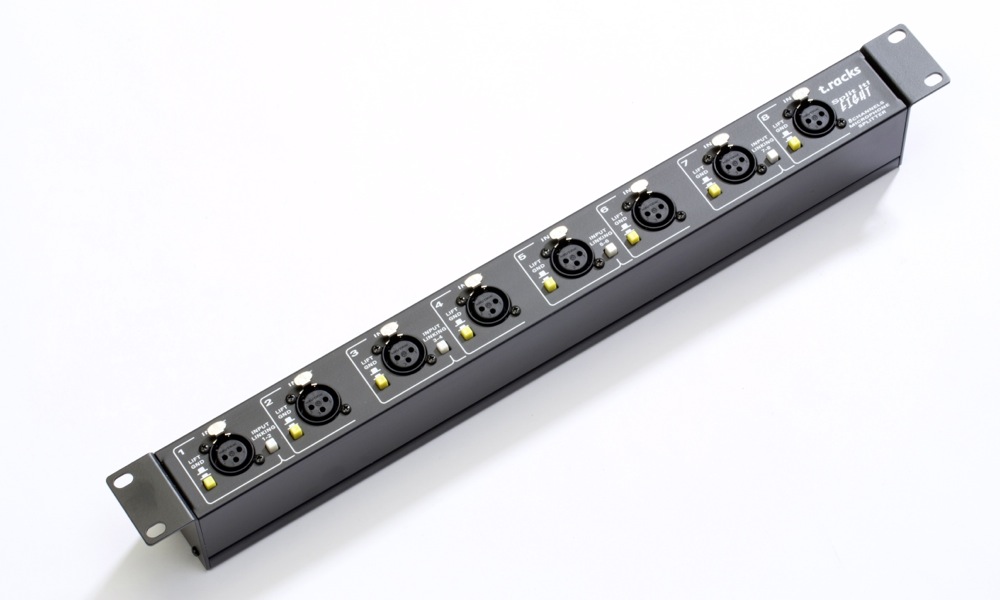Fazit
Der t.racks Eight vereint 24 Neutrik-Buchsen und acht hochwertige Übertrager, sauber auf einer soliden Platine verlötet – und das zu einem absoluten Kampfpreis. Die Einsatzmöglichkeiten des achtkanaligen Mikrofon-Splitters sind vielfältig und schließen alle Bereiche ein, in denen man Abzweigungen von den symmetrischen Originalsignalen braucht. Ob auf kleinen Bühnen in einen parallelen Monitor-Mixer, ob für das Live Recording in die DAW, ob für zusätzliche AUX-Busse oder Effektwege, hier wird sauber gesplittet. Die Abzweigungen sind galvanisch getrennt und mit dem üblichen Groundlift einer DI-Box versehen. Acht hochwertige Kanäle in einem robusten Gehäuse, schaltbar zu einer 4 x 4 Mischmatrix. Mehr geht nicht für diesen Preis!
- Schlankes Design
- Hervorragende, solide Verarbeitung
- Ground-Lift separat pro Kanal schaltbar
- 8 Mikrofonkanäle, mit je einem Parallel-Out
- Galvanische Trennung des Splitkanals
- Auch als 4 x 4 Splitter-Box durch Link-Schalter nutzbar
- Nahezu verlustfreie Übertragung
- Vergoldete XLR-Buchsen von Neutrik
- Keine Bedienungsanleitung & keine Dokumentation im Netz
- Keine Kombibuchsen für symmetrische Klinken
- Gehäuse sehr aufwendig zu öffnen






























Enrico sagt:
#1 - 12.11.2013 um 15:02 Uhr
Thank you for the very informative article, which I have enjoyed (with the help of Google Translate, that is!). However I am still confused as to how to use the phantom power option and I would very much appreciate a clarification. For instance, let's say I have a microphone that requires phantom, and I need to split the signal and send one to the mixing board and one to a recording interface (a DAW or similar). As I understand I can plug the microphone into one of the eight inputs, and then run a cable from the "link" output to the mixer input/phantom power supply.
My questions are:
1) is the above correct?
2) if I connect the isolated output to the phantom power supply, will that damage the t.racks transformer?
3) does it make any difference if I take the phantom power from the mixer or the DAW/recorder (such as a Zoom R24 for instance)?
4) finally, should the "link" out go to the mixer and the isolated out to the recorder, or viceversa? Does it make any difference?Thank you very much in advance for any reply. If I can add a comment to your great review/test of this unit, I too think it is a great device, but it lacks one important feature--a user manual for people who, like me, could use a little help with the technicalities.
Axel sagt:
#2 - 06.12.2013 um 00:13 Uhr
Hi Enrico,1) Yes - correct2) Normally 48V Shouldn´t harm the Trafo´s as it also doesn´t destroy dynamic Mic´s. But if you can avoid, don´t connect the Phantom power to the transformers.3) As long as you connect the DAW with the Link Out directly, it does not make any difference. But you can´t use the trafo out with the DAW Phanton power to run the condenser mic with. You always have to use the Phantom Power at the Link out. The Trafo out is galvanic isolated from the Input, where your Mic plugs in...4) the Link Out should go to the mixer. Isolated out to the Recorder. Other usage doesn´t make sense and will not work properly.
If you use a recorder only, then you don´t need any Splitter....